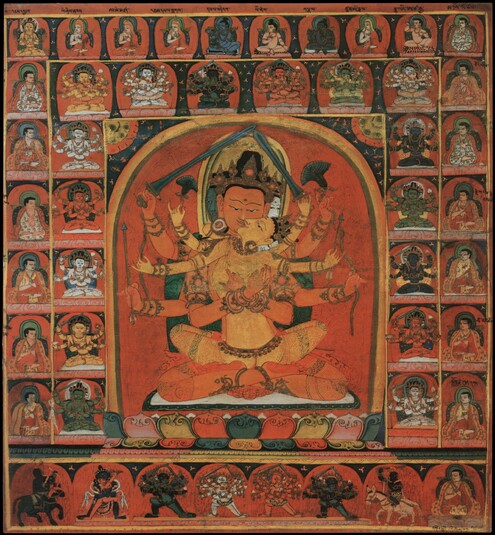
Item: Guhyasamaja (Buddhist Deity) - Manjuvajra
| Origin Location | Western Tibet |
|---|---|
| Date Range | 1300 - 1399 |
| Size | 40.70x36.80cm (16.02x14.49in) |
| Material | Ground Mineral Pigment on Cotton |
| Collection | Publication: Tibetan Paintings |
| Catalogue # | Collection of Doris Wiener Gallery, New York |
"...Manjuvajra, with a body the colour of purified gold, three faces and six hands. The main face is yellow, the right blue and the left white. The first two hands embrace the Mother. The lower right hands hold a sword and arrow, and the lower left an utpala [flower] and bow; wearing jewel ornaments and having the thirty-two major and eighty minor marks; seated with the legs in the vajra posture. In the lap is the Mother Manjuvajra with three faces and six hands, with the colour, hand objects and embrace, the same as that of the Father. Both are resting in a state of union and emanating forth rays of light." (Written by Jamyang Khyentse Wangchug, 1524-1568 reference).
The Guhyasamaja Lineage of Jnanapada: Vajradhara, Arya Manjushri, Acharya Buddha Jnana, Marmedze Zangpo, Shri Deva, Vimalagupta, Ratnavajra, Ratnakirti, Lama Pendapa, Lama Nyen Lotsawa, Lama Nang Kaupa, The Lord of Dharma Sakyapa (Sachen Kunga Nyingpo 1092-1158).
Jeff Watt 9-2000 [updated 6-2017]
Tibetan Paintings by Pratapaditya Pal (list of image plates)
Publication: Tibetan Paintings
Thematic Sets
Buddhist Deity: Manjushri (Highest Yoga Tantra)
Painting Style: Western Tibetan
Buddhist Deity: Guhyasamaja, Manjuvajra (Masterworks)
Buddhist Deity: Guhyasamaja (Early Works)
Buddhist Deity: Guhyasamaja, Manjuvajra Main Page
